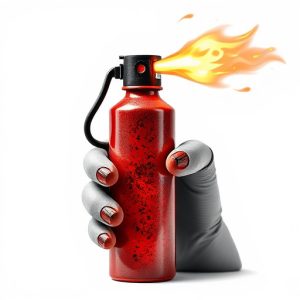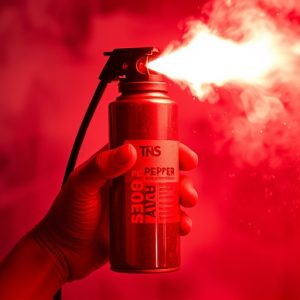Pepper Spray Safety and Usage: Chemistry, Storage, Legality, and Precautions
Pepper spray is a non-lethal self-defense tool that uses oleoresin capsicum (OC) derived from cayen…….
Pepper spray is a non-lethal self-defense tool that uses oleoresin capsicum (OC) derived from cayenne peppers to cause temporary inflammation and pain, deterring attackers. While it contains capsaicinoids that irritate the eyes, skin, and respiratory system, it is not flammable itself; however, certain formulations can ignite if exposed to a flame due to volatile organic compounds. Safe storage in cool, dry conditions away from heat sources and open flames is crucial to prevent accidental combustion and maintain the spray's effectiveness. Users must comply with local laws regarding pepper spray, which govern its use and possession. It's essential to use pepper spray as a last resort after attempting de-escalation and when no other self-defense options are available. Care must be taken to avoid exposing bystanders and the environment to the spray, emphasizing responsible use for personal safety. Proper training on handling and usage is necessary to ensure safe application and to understand the product's combustible components, which can pose a fire risk if not stored or used correctly.
When it comes to personal safety, understanding the tools at your disposal is paramount. Pepper spray, a common deterrent against aggressors, raises questions about its composition and handling due to its potent nature. This article delves into the chemistry of pepper spray, addressing concerns such as “Is pepper spray flammable?” It provides insightful guidance on safe storage and usage practices to ensure user protection. Furthermore, it explores the legal aspects and effective deployment of pepper spray in personal defense scenarios. Understanding these elements is crucial for anyone considering pepper spray as part of their safety strategy.
Understanding the Chemistry and Safety of Pepper Spray: Is It Flammable?
Understanding the chemistry behind pepper spray is essential for both its effective use and safe handling. Pepper spray, a non-lethal self-defense tool, contains oleoresin capsicum (OC), which is derived from natural sources like cayenne peppers. The active components in OC, known as capsaicinoids, are responsible for its potent irritant effects on the eyes, skin, and respiratory tract of an attacker. While pepper spray is a powerful deterrent, safety concerns arise regarding its interaction with other substances. A common question regarding pepper spray is whether it is flammable. This concern is valid as the presence of volatile organic compounds in some formulations can pose a fire risk if exposed to ignition sources. It’s crucial for users to understand that under certain conditions, such as direct exposure to heat or open flame, pepper spray can ignite and burn. Therefore, it should be stored properly, away from heat sources and in a cool environment, to prevent any accidental combustion. Safety protocols also dictate that pepper spray should not be used in confined spaces where the concentration of the mist could potentially reach harmful levels for both the user and the assailant. Proper training on the correct usage and storage of pepper spray is essential for ensuring personal safety as well as the safety of others around you.
Safe Handling Practices for Pepper Spray: Storage, Usage, and Precautions
When incorporating pepper spray into personal safety measures, adhering to safe handling practices is paramount. Proper storage is critical; pepper sprays should be kept in a cool, dry place away from direct sunlight and heat sources, as these conditions can potentially degrade the effectiveness of the spray. It’s also important to ensure that pepper spray is stored out of reach of children and pets to prevent accidental discharges.
Usage of pepper spray requires precise knowledge and understanding of its capabilities and limitations. When using pepper spray, it’s crucial to be aware that it can produce an intense irritant which may cause significant discomfort to the target individual. Additionally, users should be mindful that while pepper spray is not inherently flammable, it can ignite if exposed to an open flame or source of ignition, potentially leading to unintended consequences. Therefore, handling it with care around any potential fire hazards is essential. Always adhere to local regulations and laws governing the use of pepper spray, and consider attending a certified training course to familiarize yourself with its application in self-defense scenarios safely. Precautions such as aiming away from people and animals during practice and ensuring ventilation are key to mitigating risks associated with its usage. By following these guidelines, users can effectively utilize pepper spray while minimizing the risk of misuse or injury.
The Role of Pepper Spray in Personal Defense: Legal Considerations and Effective Use
Pepper spray, a commonly used personal defense tool, offers a non-lethal means to deter attackers by inducing temporary inflammation and pain in the eyes and respiratory system of an assailant. When considering the legal aspects surrounding its use, it’s crucial to understand that pepper spray laws vary by region. Users must be well-acquainted with their local regulations to ensure compliance with the law. In some jurisdictions, there are restrictions on the purchase, possession, and use of pepper spray. It’s a misconception to believe that pepper spray is flammable; while the chemical compounds can ignite if exposed to an open flame, the dispersed mist itself does not combust. This distinction is significant for personal safety as it means users can effectively deploy the spray without the additional risk of fire or arson charges in the event of a mishap. Proper storage and handling prevent accidental misuse or improper functioning due to heat exposure.
The effective use of pepper spray is contingent upon understanding its limitations and capabilities. It serves as a deterrent, creating an opportunity for escape or to alert authorities. When employing pepper spray, aiming directly at the face of an aggressor is typically advised, as the oleoresin capsicin (pepper extract) it contains causes intense irritation upon contact with mucous membranes. It’s important to note that while pepper spray can be a life-saving tool, its deployment should be a last resort after attempting to de-escalate the situation and when there is no other viable alternative for self-defense. Users must also consider the potential effects on bystanders and the environment; therefore, it’s essential to use pepper spray responsibly and judiciously in self-defense situations.

